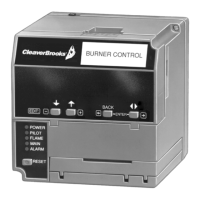CB780/CB784 RELAY MODULES
11 32-00207—01
d. Remote Reset—Use no. 22 AWG or greater
twisted pair wire, insulated for low voltage; see
Fig. 8, 9 and 10.
e. Use the recommended wire size for the 13 Vdc
full wave rectified transformer power input of no.
18 AWG wire insulated for voltages and tempera-
tures encountered in the application. Suggested
wire types include TTW(60C), THW(75C) and
THHN(90C).
5. Recommended grounding practices:
a. The earth ground provides for a connection
between the subbase and the control panel of
the equipment. The earth ground wire must be
capable of conducting the current to blow the
20A fuse (or breaker) in event of an internal short
circuit. The CB780/CB784 needs a low imped-
ance ground connection to the equipment frame
which, in turn, needs a low impedance connec-
tion to earth ground. For a ground path to be low
impedance at RF frequencies, the connection
must be made with minimum length conductors
that have a maximum surface area. Wide straps
or
brackets are preferred rather than leadwires. Be
careful to ensure that mechanically tightened
joints along the ground path, such as pipe or
conduit threads or surfaces held together with
fasteners, are free of nonconductive coatings
and are protected against corrosion on mating
surfaces.
b. Keyboard Display Module, DATA CONTROL BUS
MODULE™ or Modbus™ Module—The shield, if
used, should be connected to the signal ground
terminal 3(c) provided as part of the
CB780/CB784 device ControlBus connection.
Connect the shield at both ends to earth ground.
c. CB780/CB784—Each CB780/CB784 will have
an earth ground terminal that must be grounded
to the metal control panel with wire as short as
practical. Each ground wire must be capable of
carrying a fault current equal to the rating of the
protective fuse (20A). A number 14 copper con-
ductor is adequate, but wide straps or brackets
are preferred rather than leadwires.
6. Recommended wire routing:
a. Flame detector leadwires:
(1) Do not run high voltage ignition transformer
wires in the same conduit with the flame
detection wiring.
(2) Do not route scanner wires in conduit with
line voltage circuits.
(3) Enclose scanner wires without armor cable in
metal cable or conduit.
(4) Follow directions in flame detector Instruc-
tions.
b. DATA CONTROLBUS OR MODBUS MODULE™:
(1) Do not run high voltage ignition transformer
wires in the same conduit or close proximity
with the MODULE™ wiring.
(2) Do not route MODULE™ wires in conduit with
line voltage circuits.
c. Keyboard Display Module (VFD): Because the
VFD is powered from a low voltage, energy lim-
ited source, it can be mounted outside of a con-
trol panel if it is protected from mechanical
damage.
d. Remote Reset:
(1) Do not run high voltage ignition transformer
wires in the same conduit with the Remote
Reset wiring.
(2) Do not route Remote Reset wires in conduit
with line voltage circuits.
NOTE: A 13 Vdc power supply must be used any time
more than one Keyboard Display Module is used.
7. Maximum wire lengths:
a. CB780/CB784 leadwires—The maximum length
of leadwire is 300 feet to terminal inputs (Con-
trol, Preignition Interlock, Running/Lockout
Interlock, High Fire Switch and Low Fire Switch).
b. Flame Detector leadwires—The maximum flame
sensor leadwire length is limited by the flame
signal strength.
c. Remote Reset leadwires—The maximum length
of wire is 1000 feet to a Remote Reset pushbut-
ton.
d. DATA CONTROLBUS or MODBUS MODULE™—
The maximum module cable length depends on
the number of system modules connected, the
noise conditions and the cable used. The maxi-
mum length of all interconnecting wire is 1000
feet.
8. Make sure loads do not exceed the terminal ratings.
Refer to the label on the CB780/CB784 or to the rat-
ings in Specifications; see Table 1.
9. Check the power supply circuit. The voltage and fre-
quency tolerance must match those of the
CB780/CB784. A separate power supply circuit may
be required for the CB780/CB784. Add the required
disconnect means and overload protection.
10. Check all wiring circuits and complete the Static
Checkout, see Table 8, before installing the
CB780/CB784 on the subbase.
11. Install all electrical connectors.
12. Restore power to the panel.

